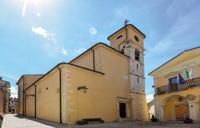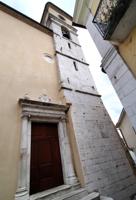Descrizione
Chiesa Parrocchiale di S. Tommaso Apostolo / Parish Church of St. Thomas Apostle
![]()
La Chiesa fu consacrata il 2 Aprile del 1300 ma un documento rinvenuto nell’archivio parrocchiale, riguardante un decreto di indulgenze, testimonia che la costruzione fosse antecedente a tale data (L. A. Antinori). La promozione come parrocchia avvenne nel 1540 quando fu dotata di fonte battesimale. Nel corso dei secoli la chiesa fu ornata da opere architettoniche di prestigio. Nel 1569 fui aggiunto il portale tardo-rinascimentale racchiuso da due colonne scanalate con capitelli ionici e architrave in pietra lavorata. Nel XVIII sec. fu allestito un coro scolpito in noce, simile a quello di Monte Cassino, un pulpito e un crocefisso ligneo. Paolo Gamba di Ripabottoni nel 1772 completò gli affreschi sulle pareti. Il terremoto del 13 Novembre 1706 causò il crollo del campanile ricostruito nel 1710 dal maestro Carlo Cole. Durante la Seconda guerra mondiale la chiesa fu incendiata e si persero tutti gli arredi lignei, le decorazioni e il prezioso archivio storico dove erano conservati documenti riguardanti più di novecento anni di storia di Barrea. Dopo la guerra la chiesa fu ristrutturata e vennero realizzati nuovi affreschi sulla parete posteriore dell’altare maggiore, eseguiti da Eroli di Roma. Il terremoto del 1984 causò il crollo parziale della volta e profonde lesioni, in seguito riparate e consolidate ma il restauro deve essere ancora ultimato.
![]()
The church was consecrated on 2 April 1300, but a document found in the parish archives, concerning a decree of indulgences, testifies that the church was built before that date (L. A. Antinori). The church was promoted to parish status in 1540 when it received a baptismal font. Over the centuries, the church was adorned with prestigious architectural works. In 1569, the late Renaissance portal was added, enclosed by two fluted columns with Ionic capitals and a carved stone architrave. In the 18th century, a choir carved in walnut, similar to the one in Monte Cassino, a pulpit and a wooden crucifix were added. Paolo Gamba from Ripabottoni completed the frescoes on the walls in 1772. The earthquake of 13 November 1706 caused the collapse of the bell tower, which was rebuilt in 1710 by Carlo Cole. During the Second World War, the church was set on fire and all the wooden furnishings, decorations and the precious historical archive containing documents related to more than nine hundred years of Barrea's history were lost. After the war, the church was renovated and new frescoes were painted on the back wall of the high altar, by Eroli of Rome. The 1984 earthquake caused the partial collapse of the vault and deep damages, which were later repaired and consolidated, but the restoration has yet to be completed.
Modalità di accesso
Accesso libero. Sempre aperto.
Indirizzo
Immagini


Ulteriori informazioni
Ultimo aggiornamento
26 settembre 2024
.png)
